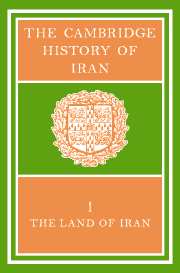Book contents
- Frontmatter
- PART 1 THE LAND
- 1 PHYSICAL GEOGRAPHY
- 2 GEOLOGY
- 3 GEOMORPHOLOGY
- 4 THE ORIGIN OF THE ZAGROS DEFILES
- 5 CLIMATE
- 6 SOILS
- 7 HYDROGRAPHY
- 8 VEGETATION
- 9 MAMMALS
- 10 ZOOGEOGRAPHIC ANALYSIS OF THE LIZARD FAUNA OF IRAN
- 11 ORNITHOLOGY
- PART 2 THE PEOPLE
- PART 3 ECONOMIC LIFE
- PART 4 CONCLUSION
- Bibliography
- Conversion Tables
- Fig. I. Iran: physiographical.
- Plate Section
- Fig 85. Soil potentiality map of Iran.
- References
3 - GEOMORPHOLOGY
from PART 1 - THE LAND
Published online by Cambridge University Press: 28 March 2008
- Frontmatter
- PART 1 THE LAND
- 1 PHYSICAL GEOGRAPHY
- 2 GEOLOGY
- 3 GEOMORPHOLOGY
- 4 THE ORIGIN OF THE ZAGROS DEFILES
- 5 CLIMATE
- 6 SOILS
- 7 HYDROGRAPHY
- 8 VEGETATION
- 9 MAMMALS
- 10 ZOOGEOGRAPHIC ANALYSIS OF THE LIZARD FAUNA OF IRAN
- 11 ORNITHOLOGY
- PART 2 THE PEOPLE
- PART 3 ECONOMIC LIFE
- PART 4 CONCLUSION
- Bibliography
- Conversion Tables
- Fig. I. Iran: physiographical.
- Plate Section
- Fig 85. Soil potentiality map of Iran.
- References
Summary
The variety and nature of morphological forms in the upland mass that forms Iran are closely determined by the prevailing climate. Just as this climate can be called an orographically conditioned variant of the general climatic type characteristic of the arid belt of the Old World, so the surface forms occurring within Iran can be characterized in an analogous manner. Climatic and geomorphological provinces can be said largely to coincide.
The massif of Iran rises generally within the Alpine orogenic zone of Eurasia. Together with its surrounding frame of mountain ranges, this massif separates the Saharan-Arabian portion of the arid zone of the northern hemisphere from its Turanian-Central Asian counterpart; and in addition, it divides the desert regions of the subtropics (deserts which have formed because of their location in relation to the tradewinds) from the dry areas of the temperate zone, which may be said to owe their aridity to an extreme continental position. The Iranian upland is subjected simultaneously to “westerly” weather conditions in the north and to effects of the monsoon in the south. The mountain ranges rise sharply from their foreland, which greatly facilitates condensation from the air masses associated with the Mediterranean, Caspian, and subtropical oceanic areas; but the resulting precipitation occurs consistently and in quantity only on the outer flanks to the west and north. The atmospheric circulation carries further moisture inland to the more sheltered highland zones, producing rainfall on the lee, or the inward-facing, slopes. This explains the extension of precipitation to the mountainous areas in the east and south of Iran.
Keywords
- Type
- Chapter
- Information
- The Cambridge History of Iran , pp. 186 - 194Publisher: Cambridge University PressPrint publication year: 1968

